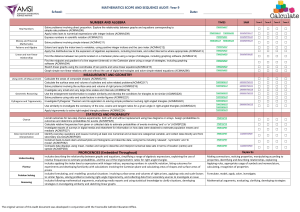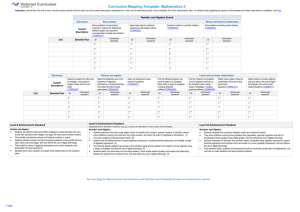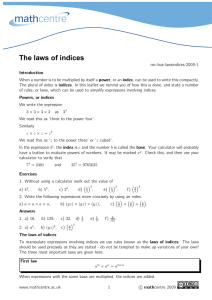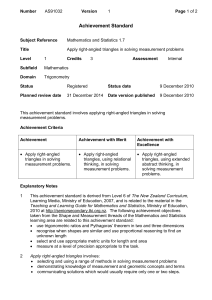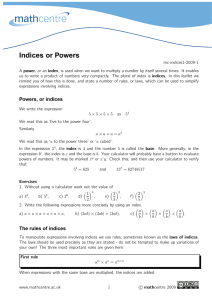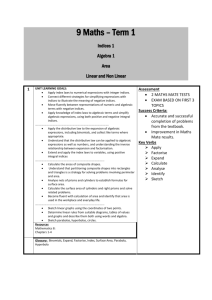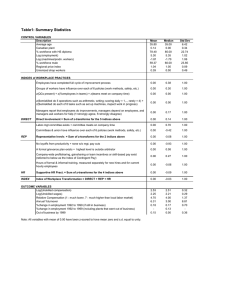Year 9 Monitoring map * Numeracy
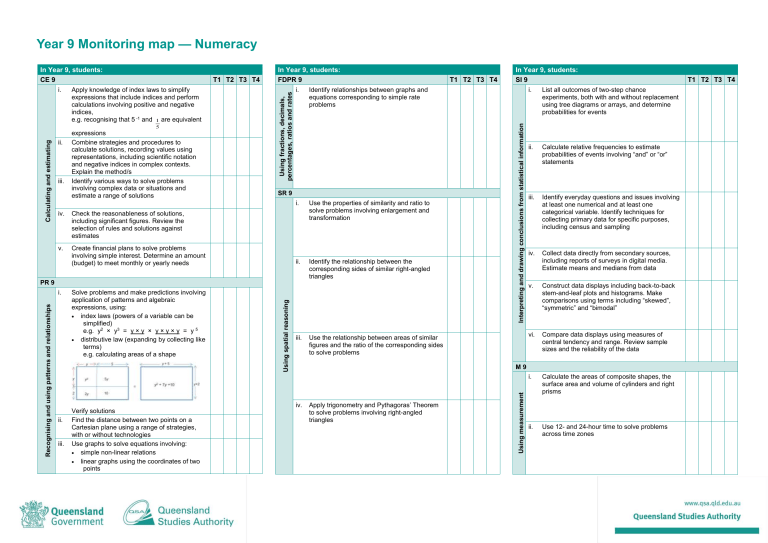
Year 9 Monitoring map — Numeracy
In Year 9, students:
CE 9 i. Apply knowledge of index laws to simplify expressions that include indices and perform calculations involving positive and negative indices, e.g. recognising that 5 -1 and
1 are equivalent
5 expressions ii. Combine strategies and procedures to calculate solutions, recording values using representations, including scientific notation and negative indices in complex contexts.
Explain the method/s iii. Identify various ways to solve problems involving complex data or situations and estimate a range of solutions iv. Check the reasonableness of solutions, including significant figures. Review the selection of rules and solutions against estimates
T1 T2 T3 T4 v. Create financial plans to solve problems involving simple interest. Determine an amount
(budget) to meet monthly or yearly needs
PR 9 i. Solve problems and make predictions involving application of patterns and algebraic expressions, using:
index laws (powers of a variable can be simplified) e.g. y 2 × y 3 = y × y × y × y × y = y 5
distributive law (expanding by collecting like terms) e.g. calculating areas of a shape
Verify solutions ii. Find the distance between two points on a
Cartesian plane using a range of strategies, with or without technologies iii. Use graphs to solve equations involving:
simple non-linear relations
linear graphs using the coordinates of two points
In Year 9, students:
FDPR 9 i. Identify relationships between graphs and equations corresponding to simple rate problems
SR 9 i. Use the properties of similarity and ratio to solve problems involving enlargement and transformation ii. Identify the relationship between the corresponding sides of similar right-angled triangles iii. Use the relationship between areas of similar figures and the ratio of the corresponding sides to solve problems iv. Apply trigonometry and Pythagoras’ Theorem to solve problems involving right-angled triangles
T1 T2 T3 T4
In Year 9, students:
SI 9 i. List all outcomes of two-step chance experiments, both with and without replacement using tree diagrams or arrays, and determine probabilities for events ii. Calculate relative frequencies to estimate probabilities of events involving “and” or “or” statements iii. Identify everyday questions and issues involving at least one numerical and at least one categorical variable. Identify techniques for collecting primary data for specific purposes, including census and sampling iv. Collect data directly from secondary sources, including reports of surveys in digital media.
Estimate means and medians from data
M 9 v. Construct data displays including back-to-back stem-and-leaf plots and histograms. Make comparisons using terms including “skewed”,
“symmetric” and “bimodal” vi. Compare data displays using measures of central tendency and range. Review sample sizes and the reliability of the data i. Calculate the areas of composite shapes, the surface area and volume of cylinders and right prisms ii. Use 12- and 24-hour time to solve problems across time zones
T1 T2 T3 T4
